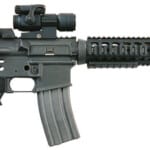
The "Brown Bess" was not simply a musket—it was a symbol of British authority and military might. This long gun was used by British and other European armies from the late 17th century through the early 19th century, playing a crucial role in shaping the course of history during this period. Not only did it see action in countless battles and wars, but it also influenced firearm development and military tactics for centuries to come.
Origin and Development
The Brown Bess is a flintlock musket, a type of firearm that was popular from the late 16th century to the mid-19th century. While the exact origins of the name "Brown Bess" are unclear, it became a common moniker for the British Long Land Pattern Musket and its successors. The term "Brown Bess" probably derived from the brown color of the walnut stock and the Germanic word "buss," meaning gun.
The predecessors of the Brown Bess included the matchlock and wheel-lock muskets of the 15th and 16th centuries. The flintlock mechanism, introduced in the late 16th century, offered a significant advantage over these older types, as it was more reliable, safer, and quicker to reload. By the late 17th century, the flintlock had become the standard ignition system for military muskets.
The Brown Bess evolved through several models. The earliest was the Long Land Pattern, introduced in 1722, which had a barrel length of 46 inches and an overall length of over 62 inches. In 1768, the Short Land Pattern, with a 42-inch barrel and overall length of 58 inches, was introduced to make the musket easier to handle. The last significant model was the New Land Pattern, introduced in 1802, which had a slightly shorter barrel and a new pattern of lock.
Manufacture and Production Numbers
The Brown Bess was produced by several manufacturers, both public and private, throughout its long service life. The Board of Ordnance, responsible for supplying the British Army, contracted various gunsmiths around the United Kingdom to manufacture the musket.
Prominent among these manufacturers were the firms of Barnett and Grice, based in London. Barnett was one of the most significant suppliers of Brown Bess muskets, active from the late 18th century through the mid-19th century. Grice was also a major manufacturer in the late 18th century, notably producing a significant number of Short Land Pattern muskets.
The exact number of Brown Bess muskets produced is unknown, but estimates run into the millions. For example, from 1793 to 1815 alone, the Board of Ordnance records indicate that nearly 3 million muskets were ordered from private contractors. Given the long service life of the Brown Bess, the total number produced was certainly much higher.
Use by the US and Other Countries
The Brown Bess was widely used by armies and militias around the world. Although it is most closely associated with the British Empire, it also saw extensive use in the American colonies, both before and during the Revolutionary War. Some American units continued to use the Brown Bess well into the 19th century, long after the United States had gained its independence.
The Brown Bess was also used by other European powers, either captured from British forces or copied and produced domestically. The French, for example, used captured Brown Besses during the Napoleonic Wars, and several German states produced their own versions of the musket.
Cartridge and Performance
The Brown Bess fired a .75 caliber round, typically a lead ball weighing about
one ounce. This was loaded with a paper cartridge, which contained the ball and a charge of black powder. The soldier would bite the end off the cartridge, pour a small amount of powder into the pan, and then ram the rest of the cartridge down the barrel with a ramrod. This process could be completed in about 20 seconds by a trained soldier, allowing for a rate of fire of about three rounds per minute.
The effective range of the Brown Bess was relatively short, about 100 yards. Beyond this distance, accuracy rapidly decreased. However, this was less of a problem in the densely packed formations of the time, where volume of fire was often more important than individual accuracy.
Comparison with Other Battle Rifles
While the Brown Bess was an effective weapon for its time, it had several limitations compared to other contemporary firearms. One notable rival was the French Charleville musket, which was similar in many respects but had a smaller .69 caliber round and a somewhat higher rate of fire. The Charleville also had a reputation for better build quality and reliability, although the differences were relatively minor.
On the American side, the Kentucky rifle was a distinctive alternative to the Brown Bess. Unlike the smoothbore Brown Bess, the Kentucky rifle had a rifled barrel, which imparted a spin to the bullet and greatly increased accuracy. However, the Kentucky rifle was slower to load and more delicate than the robust Brown Bess, making it less suitable for the harsh conditions of a battlefield.
Conclusion
The Brown Bess was more than just a weapon—it was a symbol of an era. For over a century, it was the primary firearm of the British Army and a common sight on battlefields around the world. Its distinctive design and robust construction made it an iconic weapon of the 18th and early 19th centuries. Even today, the Brown Bess remains a symbol of the age of muskets and the birth of modern warfare.
Discussion groups on Muzzleloaders can be found at the Muzzleloading Forum.
If you know of any forums or sites that should be referenced on this listing, please let us know here.



